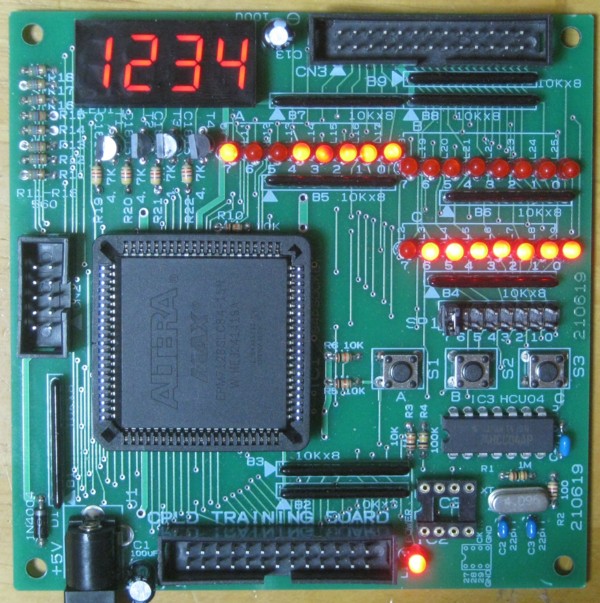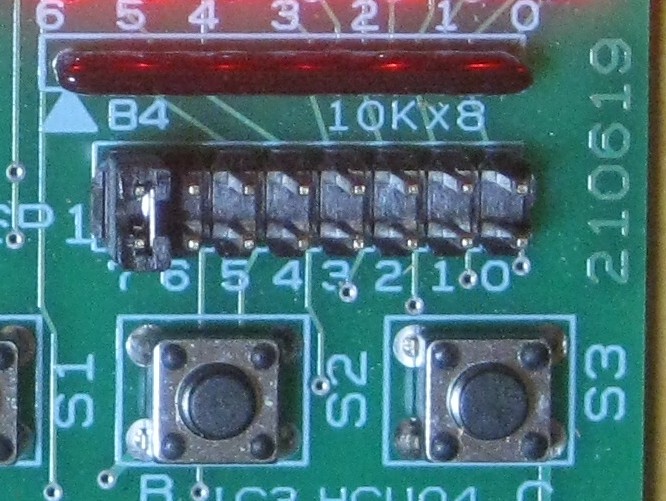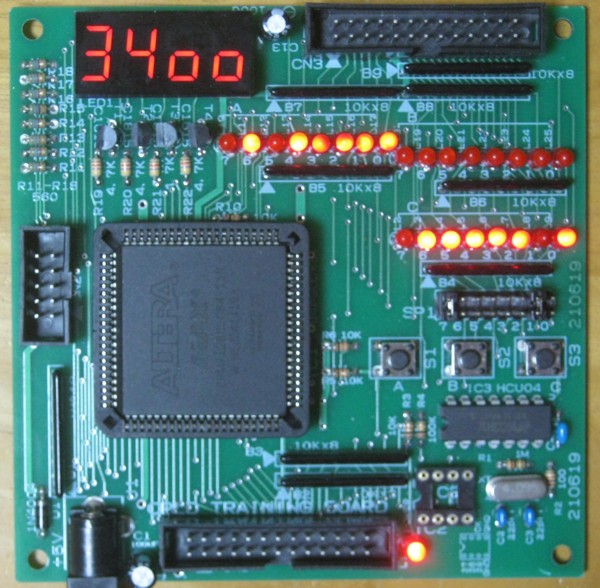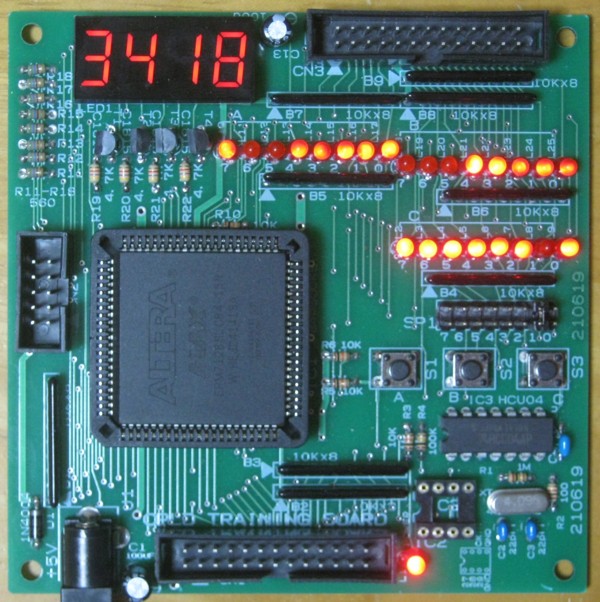--cpld training 19/5/25 5/26 5/27 5/28 5/29
--5/31 8/21 8/22 9/7
library IEEE;
use IEEE.STD_LOGIC_1164.ALL;
library ARITHMETIC;
use ARITHMETIC.std_logic_arith.all;
entity trngwatch1d is
PORT (
-- T27:out std_logic;
-- T29:out std_logic;
SEGOUT:out std_logic_vector(7 downto 0);
LEDOUT:out std_logic_vector(3 downto 0);
CK1:in std_logic;
-- CK2:in std_logic;
-- CK3:in std_logic;
SWA:in std_logic;
SWB:in std_logic;
SWC:in std_logic;
-- ADRSIN:in std_logic_vector(7 downto 0);
-- DINOUT:inout std_logic_vector(7 downto 0);
PA:out std_logic_vector(7 downto 0);
PB:out std_logic_vector(7 downto 0);
PCL:in std_logic_vector(3 downto 0);
PCH:in std_logic_vector(3 downto 0)
);
-- IOR:in std_logic;
-- IOW:in std_logic);
end trngwatch1d;
architecture rtl of trngwatch1d is
signal cntr1:std_logic_vector(11 downto 0);--1khz 4096=2**12
signal tm1:std_logic_vector(3 downto 0);--1/1000 sec
signal cntrss0:std_logic_vector(3 downto 0);--1/100 sec
signal cntrss1:std_logic_vector(3 downto 0);--1/10 sec
signal leddatabf0:std_logic_vector(3 downto 0);
signal leddatabf1:std_logic_vector(3 downto 0);
signal leddatabf2:std_logic_vector(3 downto 0);
signal leddatabf3:std_logic_vector(3 downto 0);
signal leddatawk:std_logic_vector(3 downto 0);
signal segdata:std_logic_vector(7 downto 0);
signal ledoutbf:std_logic_vector(3 downto 0);
signal ledcntr:std_logic_vector(2 downto 0);
signal ledadrs:std_logic_vector(2 downto 0);
signal cntrs0:std_logic_vector(3 downto 0);
signal cntrs1:std_logic_vector(2 downto 0);
signal cntrm0:std_logic_vector(3 downto 0);
signal cntrm1:std_logic_vector(2 downto 0);
signal cntrh:std_logic_vector(5 downto 0);
--signal cntrh1:std_logic_vector(1 downto 0);
signal tm0:std_logic;
signal cntrm0ck:std_logic;
signal cntrm1ck:std_logic;
signal cntrhck:std_logic;
--
begin
PA<=cntrss1 & cntrss0;
PB<='0' & cntrs1 & cntrs0;
-- 7seg drive clock 1KHz from 4096KHz
process(CK1)
begin
if CK1'event and CK1='1' then
cntr1<=cntr1+"000000000001";
end if;
end process;
-- led drive,LEDOUT
process(cntr1)
begin
if cntr1(11)'event and cntr1(11)='0' then
ledcntr<=ledcntr+"001";
ledoutbf<=ledoutbf(2 downto 0) & '0';
end if;
if ledcntr(2)='1' then
ledcntr<="000";
ledoutbf<="0001";
end if;
end process;
--
LEDOUT<=ledoutbf;
SEGOUT<=segdata;
-- led data out
process(ledcntr)
begin
if ledcntr(1 downto 0)="00" then
leddatawk<=leddatabf0;
elsif ledcntr(1 downto 0)="01" then
leddatawk<=leddatabf1;
elsif ledcntr(1 downto 0)="10" then
leddatawk<=leddatabf2;
elsif ledcntr(1 downto 0)="11" then
leddatawk<=leddatabf3;
end if;
end process;
--segment change
process(leddatawk)
begin
if leddatawk="0000" then
segdata<="01011100";
elsif leddatawk="0001" then
segdata<="00000110";
elsif leddatawk="0010" then
segdata<="01011011";
elsif leddatawk="0011" then
segdata<="01001111";
elsif leddatawk="0100" then
segdata<="01100110";
elsif leddatawk="0101" then
segdata<="01101101";
elsif leddatawk="0110" then
segdata<="01111101";
elsif leddatawk="0111" then
segdata<="00000111";
elsif leddatawk="1000" then
segdata<="01111111";
elsif leddatawk="1001" then
segdata<="01101111";
end if;
end process;
--
-- ******* watch ******
--
tm0<=cntr1(11);
--1/1000
process(tm0)
begin
if tm0'event and tm0='0' then
tm1<=tm1+"0001";
end if;
if tm1="1010" then
tm1<="0000";
end if;
end process;
-- 1/100sec
process(tm1(3))
begin
if tm1(3)'event and tm1(3)='0' then
cntrss0<=cntrss0+"0001";
end if;
if cntrss0="1010" then
cntrss0<="0000";
end if;
end process;
--
--1/10sec
process(cntrss0(3))
begin
if cntrss0(3)'event and cntrss0(3)='0' then
cntrss1<=cntrss1+"001";
end if;
if cntrss1="1010" then
cntrss1<="0000";
end if;
end process;
--secondL
process(cntrss1(3),PCH(3))
begin
if cntrss1(3)'event and cntrss1(3)='0' then
cntrs0<=cntrs0+"0001";
end if;
if cntrs0="1010" or PCH(3)='0' then
cntrs0<="0000";
end if;
end process;
--secoudH
process(cntrs0(3),PCH(3))
begin
if cntrs0(3)'event and cntrs0(3)='0' then
cntrs1<=cntrs1+"001";
end if;
if cntrs1="110" or PCH(3)='0' then
cntrs1<="000";
end if;
end process;
--swcon set(every 1 second)
--select counterm0 clock
process(SWC,cntrs1(2),cntrss1(3))
begin
if SWC='0' then
cntrm0ck<=cntrss1(3);-- if SWC on,then count up every 1 sec
else
cntrm0ck<=cntrs1(2);
end if;
end process;
process(cntrm0ck)
begin
if cntrm0ck'event and cntrm0ck='0' then
cntrm0<=cntrm0+"0001";
end if;
if cntrm0="1010" then
cntrm0<="0000";
end if;
end process;
--minuteH
--swbon set(every 1 second)
--select counterm1 clock
process(SWB,cntrm0(3),cntrss1(3))
begin
if SWB='0' then
cntrm1ck<=cntrss1(3);-- if SWB on,then count up every 1 sec
else
cntrm1ck<=cntrm0(3);
end if;
end process;
--
process(cntrm1ck,SWC)
begin
if cntrm1ck'event and cntrm1ck='0' and SWC='1' then
cntrm1<=cntrm1+"001";
end if;
if cntrm1="110" then
cntrm1<="000";
end if;
end process;
--hour
--swaon set(every 1 second)
--select counterh clock
process(SWA,cntrm1(2),cntrss1(3))
begin
if SWA='0' then
cntrhck<=cntrss1(3);-- if SWA on,then count up every 1 sec
else
cntrhck<=cntrm1(2);
end if;
end process;
--
process(cntrhck,SWB)
begin
if cntrhck'event and cntrhck='0' and SWB='1' then
cntrh<=cntrh+"000001";
end if;
if cntrh(3 downto 0)="1010" then
cntrh(3 downto 0)<="0000";
cntrh(5 downto 4)<=cntrh(5 downto 4)+"01";
elsif cntrh="100100" then
cntrh<="000000";
end if;
end process;
--7seg disp select
--HHMM or MMSS
process(PCL,cntrss0,cntrss1,cntrs0,cntrs1,cntrm0,cntrm1)
begin
if PCL(0)='0' then
leddatabf3<=cntrss0;
leddatabf2<=cntrss1;
leddatabf1<=cntrs0;
leddatabf0<='0' & cntrs1;
elsif PCL(1)='0' then
leddatabf3<=cntrs0;
leddatabf2<='0' & cntrs1;
leddatabf1<=cntrm0;
leddatabf0<='0' & cntrm1;
else
leddatabf3<=cntrm0;
leddatabf2<='0' & cntrm1;
leddatabf1<=cntrh(3 downto 0);
leddatabf0<="00" & cntrh(5 downto 4);
end if;
end process;
--
end rtl;
|



